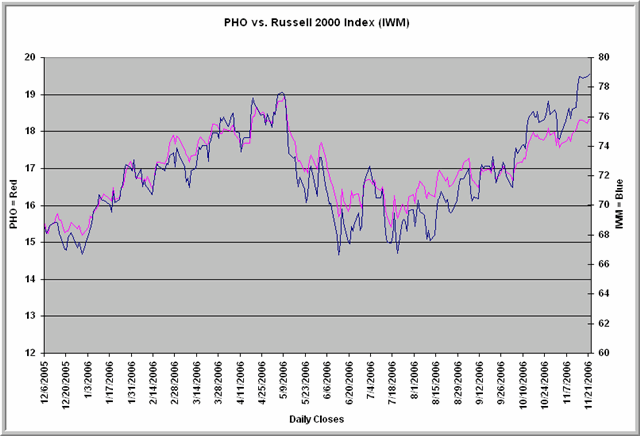Will this ETF keep investor profits flowing?
The New Yorker recently
published
an
eye-opening article on the water shortage in the
developing world and the possibility of global catastrophe. News
reports of
pollution in China’s Yellow River and
competition
for water resources in India lend credence to the concern. Could water be
the next oil, a commodity
with huge price appreciation
potential? The PowerShares Water Resources ETF
(
PHO |
Quote |
Chart |
News |
PowerRating) is
one way to take advantage of
this theme through a diversified group of stocks.
The
PowerShares site
explains that PHO is based on the Palisades Water Index, which tracks companies
that focus on the provision of potable water, water treatment, and technology
devoted to water consumption. Over 52% of the portfolio consists of small-cap
issues, while large cap accounts for about 11% and mid-cap about 37%.
Industrials and utilities represent the largest sectors at nearly 60% and over
25% respectively. Over 36% of the portfolio is concentrated in the top ten
holdings.
So how does the ETF behave? As the chart below
indicates, PHO has been strongly correlated with the small cap stocks since its
inception. It remains below its May peak, thus behaving more like a small cap
growth stock than a value issue. The correlation between daily price changes in
PHO and IWM is .81, meaning that over 64% of the variance in PHO price from day
to day is accounted for by movement within the broad small-cap universe. The
average price change from day to day in PHO is only slightly greater than for
IWM: .96% vs. .87%. Interestingly, average volume for PHO has not grown over
its relatively short lifetime. It peaked during its price rise in April, 2006
and is down to early 2006 levels at present.

My
earlier report on a promising sector ETF, the PowerShares WilderHill Clean
Energy Fund
(
PBW |
Quote |
Chart |
News |
PowerRating), found that this fund has been growing its volume and is
considerably more volatile than the Russell index. This points to a difference
between the two funds: clean energy may be more on the radar of U.S. investors
than water resources and hence generating greater speculative interest. It is
far easier to see Congress and the President moving on meaningful domestic
alternative energy funding than water initiatives in developing countries.
Nonetheless, there appears to be
growing interest in ETFs with a conscience since the Democratic victory in
Congress, so I’m keeping my eye on PHO. It has underperformed the recent market
rally and its component stocks sport a generous 22 multiple to current
earnings. Given the strong correlation with the small cap indices, my leaning
is to wait for the next market pullback and assess the action in PHO from
there. Although initial volume has been impressive for a relatively new ETF, I
will want to see growing investor participation in the fund as a sign that the
water-as-natural-resource theme is taking hold.
Brett N. Steenbarger,
Ph.D. is Associate Clinical Professor of Psychiatry and Behavioral Sciences at
SUNY Upstate Medical University in Syracuse, NY and author of
The Psychology of Trading (Wiley, 2003). As
Director of Trader Development for Kingstree Trading, LLC in Chicago, he has
mentored numerous professional traders and coordinated a training program for
traders. An active trader of the stock indexes, Brett utilizes
statistically-based pattern recognition for intraday trading. Brett does not
offer commercial services to traders, but maintains an archive of articles and a
trading blog at
www.brettsteenbarger.com and a blog of market
analytics at
www.traderfeed.blogspot.com. His book,
Enhancing Trader Performance, was
recently released for publication (Wiley).
